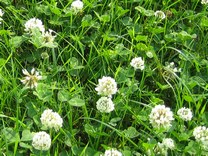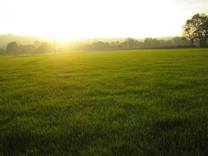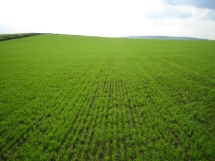Utilising Grass and Clover to Control Rising Costs
Predictions are that feed prices will also rise further and will remain at higher levels than we have seen in recent years as a result of increased
demand for bio-fuels. Despite other costs having risen, higher milk prices should bring profit opportunities for dairy farmers.
Nevertheless it is a fact that milk yield from forage on UK dairy farms has declined over the past 10 years. This is despite improved grass, clover and maize seed varieties available. It is despite the massive improvements that have been made in terms of advances in machinery and technology available and despite the major strides made by many farms in adopting modern rotational grazing techniques, soil aerators, spring tine harrow overseeders, slurry injection, improved soil management and crop nutrient balancing etc.
Taking a fresh look at how we utilise forage in the UK has the potential to massively reduce purchased feed cost per litre without reducing overall milk output. In fact increasing milk yield from forage without reducing concentrates is a perfectly legitimate means of lifting overall output and therebye reducing feed cost per litre in high yielding herds.
It is essential that we continue to improve both the quality and the quantity of forage that we produce within the UK dairy industry
Increasing Output from Home Grown Forage
Most forage fed is produced on the farm and generally makes up the major part of the diet. Forage crops should be grown with the same diligence and attention to detail as arable crops grown for sale. Focus on the quality and quantity of forage grown, forage access and efficiency of forage utilisation and how conservation losses can be reduced. In short get more from forage, which doesn't mean, simply getting less from concentrates.
Great advances have been made in both in grass and in clover breeding in the UK in recent years. Progress in ryegrass breeding has seen yields increase over the last two decades by an average of 1% per year, and the very latest varieties offer significant advantages in terms of digestibility, palatability and high sugar levels.
An effective reseeding strategy to make full use of these new varieties across the whole farm can boost milk yields and reduce both fertiliser and feed inputs
 The use
of white clover in grazing swards has been a great success. With pressure on fertiliser nitrogen prices
the use of white clover in UK grassland has become much more widespread.
The use
of white clover in grazing swards has been a great success. With pressure on fertiliser nitrogen prices
the use of white clover in UK grassland has become much more widespread.
Grass clover swards need to be managed for the clover rather than for the grass. Clover in well managed swards can generate up to 250kg Nitrogen / ha and will often out yield grass only swards, even where there are high nitrogen inputs.
Clover is higher in energy and protein content than grass. It is better in drought conditions than grass and does an excellent job of improving soil structure. Grass clover swards also graze better with less need for topping especially when used in conjunction with the new Aber High Sugar Grass varieties.
Emphasis on reseeding, grassland management and more efficient conservation of forages should now be a priority for dairy farmers in order to offset rising feed and fertiliser prices
There have been many advances recently. Soil aeration can boost yields by up to 30% especially on grass clover swards. Great strides have also been made with over-seeding techniques, slurry injection, new bio-fertilisers and a greater appreciation for the need to balance trace elements and other nutrients on grassland.
RWN has been at the forefront of many of these advances and is well placed to advise on the best routes to follow. We are also heavily involved with some really outstanding new maize seed varieties as well as various other forage crops relevant to UK agriculture.
Grassland Improvement
Now is a good time to assess sward quality and determine the reseeding priorities for this autumn. It is easy to carry out a simple stem base check to identify the proportion of ryegrasses in relation to weed grasses. As a general rule ryegrasses are red at the base of the stem and weed grasses are not, therefore it is easy to work out the level of weed ingress in a sward, simply by pulling up a random selection of plants all over the field, and working out the relative proportion of ryegrasses to weed grasses. To be doubly sure, check that the underside of the leaf is shiny - if you have a combination of a red stem base and shiny underside on the leaf, it's a ryegrass!
How productive were your silage leys this year?
 Weed grasses such as the meadow grasses, creeping bent and Yorkshire fog are less productive,
lower in quality and less responsive to nitrogen than commercially bred ryegrasses, so any level of
ingress is going to reduce the productivity of your sward. As a guide, swards should contain at least
two thirds of their originally sown species, otherwise it is probably time to reseed or at least rejuvenate
the sward with over-seeding.
Weed grasses such as the meadow grasses, creeping bent and Yorkshire fog are less productive,
lower in quality and less responsive to nitrogen than commercially bred ryegrasses, so any level of
ingress is going to reduce the productivity of your sward. As a guide, swards should contain at least
two thirds of their originally sown species, otherwise it is probably time to reseed or at least rejuvenate
the sward with over-seeding.
Other factors to take into account should include any evidence of bare ground, plus the level of non-grass weeds such as docks and thistles present. Bare ground in a grazing sward is both unproductive and an opportunity for weeds to establish, so take this into account when making your reseeding decisions.
Grassland older than 10-15 years will reduce profitability?
Most leys over 10 years old will have lost a fair proportion of ryegrass. Even where pasture has a high percentage of ryegrasses (red stem base and shiny leaf), grass seed from varieties more than 10 years ago will be less productive than recent varieties. This will show up in lower yields, less response to fertiliser, lower D-Values and sugar levels, reduced animal performance or higher feed costs.
RWN Grass and Clover Seed Benefits
It has been estimated that RWN Grass and Clover Seeds can generate up to
�500/acre additional profit per acre over the life of the ley compared to other seed
RWN Grass Seeds Mixtures are formulated to the very highest possible specification using only the best varieties available. Our seed mixtures are designed specifically for dairy farms and are based on the new Aber High Sugar Grass varieties which have been shown to produce up to 2.5 litres more milk per cow per day than conventional grass seed varieties. These new varieties are bred by IGER especially for UK agricultural conditions. Not only are they extremely high yielding, show excellent disease resistance and are higher in energy than most other varieties but are also very palatable. This means that under grazing, intakes are higher and a higher proportion of the sward is utilised with less waste and with less need for topping.
Not All Grass Seeds Mixtures Are Equal? Always buy the best available
 RWN
Grass and Clover Seed Mixtures include a range of Aber White Clovers which again have been developed
particularly for the UK.
RWN
Grass and Clover Seed Mixtures include a range of Aber White Clovers which again have been developed
particularly for the UK.
These offer clear advantages over older clover varieties including a longer growing season, higher yields, easier establishment, greater reliability, greater nitrogen tolerance and are particularly well suited to use on dairy farms. As with all our products, our seeds are selected to provide maximum advantage to the farmer not the seedsman.
Summary
- Feed prices in future are likely to remain at higher levels than we have been used to in the past, but then at the same time so are milk prices
- The most effective means of offsetting rising feed prices is still to feed cows to produce high yields in order to spread overhead costs over more litres
- Dairy cow diets should be balanced to provide maximum rumen efficiency to get the most out of increasingly costly feeds, whether they are concentrates or forages
- Full advantage should be made of new techniques, technical developments and new grass, clover and maize seed varieties
- All the indicators are optimistic about the future. In addition, I cannot remember a time where there have been so many exciting new advances in forage crops, forage conservation, feeding and dairy nutrition open to dairy farmers
Higher milk prices should encourage re-investment and uptake of these new advances to allow cost savings and greater profitability for dairy farmers.
Contact Richard Webster for advice on making more of forage to control costs
